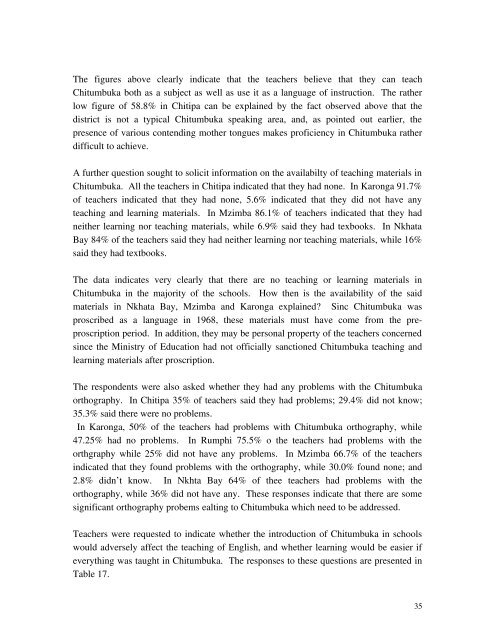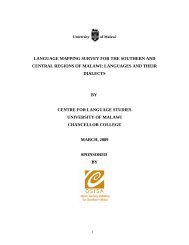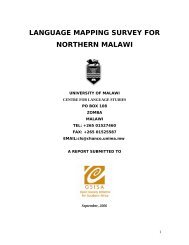SOCIOLOLINGUISTIC SURVEYS - Centre for Language Studies
SOCIOLOLINGUISTIC SURVEYS - Centre for Language Studies
SOCIOLOLINGUISTIC SURVEYS - Centre for Language Studies
Create successful ePaper yourself
Turn your PDF publications into a flip-book with our unique Google optimized e-Paper software.
The figures above clearly indicate that the teachers believe that they can teach<br />
Chitumbuka both as a subject as well as use it as a language of instruction. The rather<br />
low figure of 58.8% in Chitipa can be explained by the fact observed above that the<br />
district is not a typical Chitumbuka speaking area, and, as pointed out earlier, the<br />
presence of various contending mother tongues makes proficiency in Chitumbuka rather<br />
difficult to achieve.<br />
A further question sought to solicit in<strong>for</strong>mation on the availabilty of teaching materials in<br />
Chitumbuka. All the teachers in Chitipa indicated that they had none. In Karonga 91.7%<br />
of teachers indicated that they had none, 5.6% indicated that they did not have any<br />
teaching and learning materials. In Mzimba 86.1% of teachers indicated that they had<br />
neither learning nor teaching materials, while 6.9% said they had texbooks. In Nkhata<br />
Bay 84% of the teachers said they had neither learning nor teaching materials, while 16%<br />
said they had textbooks.<br />
The data indicates very clearly that there are no teaching or learning materials in<br />
Chitumbuka in the majority of the schools. How then is the availability of the said<br />
materials in Nkhata Bay, Mzimba and Karonga explained? Sinc Chitumbuka was<br />
proscribed as a language in 1968, these materials must have come from the preproscription<br />
period. In addition, they may be personal property of the teachers concerned<br />
since the Ministry of Education had not officially sanctioned Chitumbuka teaching and<br />
learning materials after proscription.<br />
The respondents were also asked whether they had any problems with the Chitumbuka<br />
orthography. In Chitipa 35% of teachers said they had problems; 29.4% did not know;<br />
35.3% said there were no problems.<br />
In Karonga, 50% of the teachers had problems with Chitumbuka orthography, while<br />
47.25% had no problems. In Rumphi 75.5% o the teachers had problems with the<br />
orthgraphy while 25% did not have any problems. In Mzimba 66.7% of the teachers<br />
indicated that they found problems with the orthography, while 30.0% found none; and<br />
2.8% didn’t know. In Nkhta Bay 64% of thee teachers had problems with the<br />
orthography, while 36% did not have any. These responses indicate that there are some<br />
significant orthography probems ealting to Chitumbuka which need to be addressed.<br />
Teachers were requested to indicate whether the introduction of Chitumbuka in schools<br />
would adversely affect the teaching of English, and whether learning would be easier if<br />
everything was taught in Chitumbuka. The responses to these questions are presented in<br />
Table 17.<br />
35





